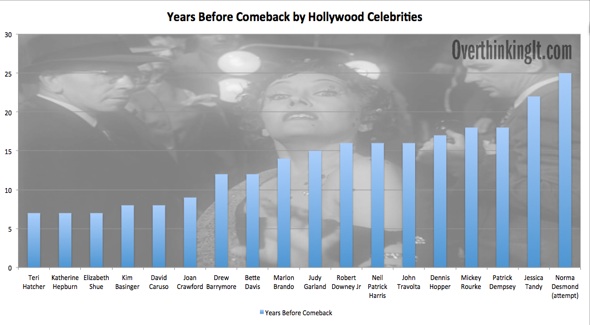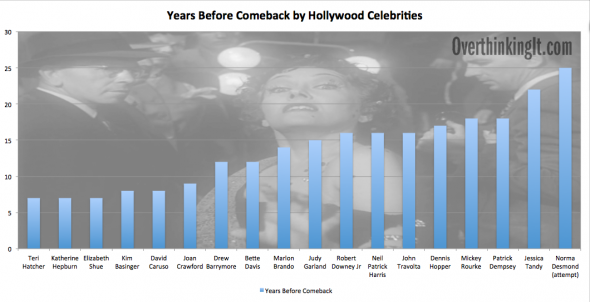We all have a shameful list of classic movies that we’ve gone far too long without seeing. For years, Sunset Boulevard was one of mine. In my defense, Sunset Boulevard has become so ingrained in Western culture that one can almost discern the plot from its memorable quotes and images. “All right, Mr. DeMille – I’m ready for my close-up.” Gloria Swanson leering at the camera, or glaring under hooded eyes. Hell, the movie begins by spoiling the fate of the protagonist – I knew half the story already!
And yet, watching the movie for the first time, as I did this past weekend, I was struck by Norma Desmond’s quest to return to stardom. Desmond’s attempting to stage a comeback, a return to her celebrity heyday with an epic script. It’s never stated exactly how many years ago she was a star, but stardom is such an imprecise quantity (not counting the Iron Law of Stardom, of course) that it would be hard to benchmark. There are several references to “twenty years” in dialogue – Desmond having waited twenty years for deMille to call her; Desmond “playing to an empty house” since “the audience left twenty years ago,” and so forth. William Holden’s character, Joe Gillis, also makes reference to a woman of fifty trying to be twenty-five. So we’ll say that the peak of Norma Desmond’s stardom was twenty to twenty-five years ago.
Does that strike you as very long? I observed after seeing the film that the modern-day equivalent would be Brooke Shields wasting away in a mansion, waiting for Louis Malle to call her back. It seems silly to think of Shields, or any actor from the early 80s, as a delusional recluse pining for another shot at stardom. But that’s because many of them have kept working, albeit in diminishing roles, or have aged gracefully into the next phase of their career. It’s only Norma Desmond’s character who is frozen in the past.
But even so, twenty-five years did not strike me as such a ludicrous length of time. Gillis struggles to remember her upon first meeting her (“you used to be big”). The only folks who remember her at the Paramount lot are industry veterans – an aged security guard, a game old stagehand, and the actors who would recognize her name as a legend. Is twenty-five years ancient history in Hollywood? Does a mere generation consign one’s name to the dustbin?
Just how long can someone go before making a comeback, anyway?
This being Overthinking It, I realized I needed data. So data I obtained.
This chart (click to enlarge) tracks years between the last big hit and the comeback of various celebrities. I picked big names that had distinct phases in their careers separated by a significant length of time. And that separation must have been marked by diminishing career fortunes. Will Smith has had different phases of his career (teen rapper to TV actor to action superstar to father figure), but he’s never dropped off the radar for an extended period. Robert Downey Jr, on the other hand, had a lot of lean years.
Some obvious limitations I must confess:
1. n=17 is not a huge sample size. You can get published with less, but I’d still rather have significant data. But it’s hard to clearly define what constitutes a comeback (for reasons elucidated below), so this was the biggest list I felt confident in. If you think there’s anyone obvious I missed, sound off in the comments!
2. What qualifies as a “comeback” is a fuzzy term. I defined it as being given top billing in a hit show or movie. Drew Barrymore was in many movies between Firestarter and Scream, for instance – including the critically regarded Everyone Says I Love You and the summer hit Batman Forever – but Scream was the biggest movie in which she received top billing.
3. The columns on the chart above measure years between a comeback performance and one’s last big hit. The “last big hit” is equally fuzzy. For instance, was The Young Lions Brando’s last hit before his comeback, or was it Guys and Dolls?
4. Achieving a comeback is something that can only be defined after the fact. For instance, Jenny McCarthy might have been going for a comeback with 2005 bomb Dirty Love. Meanwhile, who would have expected that John Travolta could find a career again, 16 years after Grease? It’s pretty subjective.
In short, the data aren’t perfect. But what can we learn from the data we have?
1. The mean number of years between a last hit and a comeback (what I’m calling the sunset period, in honor of the movie that inspired this exercise) is 13.05, with a standard deviation of 4.71. That means, if successful sunsets fall in a normal distribution, that more than two-thirds of all comebacks will be between 8 years and 17 years after a star’s last big hit. That doesn’t mean a star who’s been off the market for 20 years can’t make a comeback, since “the odds that a comeback after an x-year sunset will succeed” and “the odds that an artist’s sunset will be x years” are two different measurements. But since every comeback on this list is a successful comeback, it tells us that a star’s ability to regenerate is pretty short.
2. Nine of the seventeen stars on this list are female; eight are male. Of those nine, seven are clustered in the first half of the distribution of sunsets. Only Judy Garland and Jessica Tandy pulled off a comeback after a sunset of greater than twelve years. This suggests that the shelf life of a female actor is much shorter than that of a male, which dovetails with conventional wisdom.
3. And nobody has actually managed a comeback after a 25-year sunset. Of course, Norma Desmond’s case was unique. She was not only attempting a comeback, but trying to play a role she was clearly unsuited for: the magnificent, seductive Salome, daughter of Herod. Every real actor who’s made a successful comeback has done so by redefining themselves. In showing their ability to take on a new type – the aging warrior instead of the young punk, the elder statesman instead of the tempestuous rebel, the femme fatale instead of the damsel in distress – they’ve extended the lifespan of their career.
Of course, as with all good research, this data needs to be disseminated and vetted. So have at it, Overthinkers! What, if anything, have we learned?


Really interesting article on how the plot of Sunset Boulevard parallels Gloria Swanson’s own comeback, after a somewhat comparable lapse: http://thehairpin.com/2012/10/scandals-of-classic-hollywood-the-gloria-swanson-saga-two
That’s a phenomenal article – thank you!
I always thought Norma Desmond was supposed to be a silent film star who was left behind by the rise of talkies. That might be why no one at Paramount remembers her — and why her grandiose gestures and choice of role seem so absurd for 1950s cinema.
As data points you should use George Burns and Don Amechie.
The thing is it’s all about the project. It doesn’t matter what the span of time is, if the project is right and it works… you’re back! Ahnold is trying it right now.
Of course, wallowing in obscurity makes the availability of projects remote unless they are personally underwrit but nobody said it would be easy. It also shows you why Cage, Willis and Seagal do so many movies… just to keep in the “eye”.
I think Hollywood in the twenties and thirties might be compared to the theatre business in certain aspects: once a movie ceased to find audiences it more or less disappeared. No tv to show older movies, few revivals in movie theatres, no video to own it. Whereas even when John Travolta dropped off the radar of watchable movies, we always had opportunities to watch and remember Grease or Saturday Night Fever.
Combined with the move to talkies (and color!), the distance between 1925 and 1955 is far greater than between 1975 and 2005.
To press on the theatre-metaphor: I can imagine a big Broadway star of the early eighties to sit in a small (right now darkened) Manhattan appartment, bitter and forgotten…
One of the other issues is what is obscurity? Just because they are not in front of a camera, doesn’t mean that they’re away. Tandy is a case in point. She never stopped working just wasn’t in front of a camera. She was always more interested in the stage. Her and Hume Croyn had at least one play a year going on Broadway.
Matthew Broderick is the current poster boy for that sort of activity.
OTOH Simber is so right. There is now a more evergreen aspect to media stars. They have become truly immortal. John Wayne is still an icon. What do you think of when you think of Clint Eastwood? Not today’s version I wager. Is Swayze dead? Not until Roadhouse or Ghost can’t be played anymore.
Another thing… that evergreen aspect hurts women far more. It’s a bitch when you looked like Jennifer Connelly and now you look like Judy Dench.
It’s probably not accurate to call Iron Man RDJ’s comeback… because he was never really here to begin with.
http://boxofficemojo.com/news/?id=2813&p=.htm
The problem with that article is that it doesn’t even mention his arthouse movies like his role in Ian McKellan’s brillant alternate-universe 1930s Richard III. RDJ may not have had much impact as far as the box office biggies prior to Iron Man, but his critical reputation was well established.
See qualification number 2 from above;
What qualifies as a “comeback” is a fuzzy term. I defined it as being given top billing in a hit show or movie. Drew Barrymore was in many movies between Firestarter and Scream, for instance – including the critically regarded Everyone Says I Love You and the summer hit Batman Forever – but Scream was the biggest movie in which she received top billing.
But surely an Oscar nomination (Chaplin) counts as a comparable qualification?
Also, you list Grease as Travolta’s last hit movie before Pulp Fiction, but Look Who’s Talking made $297 million in 1989.
I would be curious to see Betty White plotted on here. Of course, she’s bound to be an outlier, as even in her heyday the first time around she was more famous as “famous old woman” than “sexy young starlett,” so a lot of the youth/beauty/sex appeal factors don’t really apply to her.
Of course, a quick look up on IMDB just showed me that Betty White was working pretty consistently from the time Golden Girls went off the year up until now, so the question might be, what constitutes a comeback. I don’t think anyone would deny that Betty White is much bigger now than she was 10 years ago, but in an objective sense (based on disappearing from the screen altogether, which I believe is Perich’s definition if I’m understanding correctly), she was never really gone.